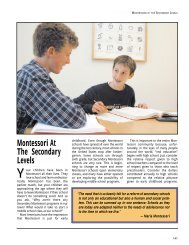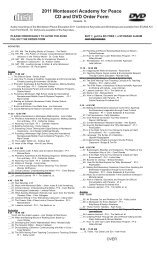Tim Seldin & Paul Epstein Ph.D. An Education for Life
Tim Seldin & Paul Epstein Ph.D. An Education for Life
Tim Seldin & Paul Epstein Ph.D. An Education for Life
You also want an ePaper? Increase the reach of your titles
YUMPU automatically turns print PDFs into web optimized ePapers that Google loves.
MONTESSORI PROGRAMS<br />
Today, we know that<br />
this prejudice is<br />
illogical, as research<br />
supports the premise<br />
that the most<br />
important years of<br />
a child’s education<br />
are not the years of<br />
high school and college<br />
but those of<br />
the first six years<br />
of life. This is the<br />
foundation of everything<br />
that will follow.<br />
Illogical as this<br />
prejudice may be, it<br />
is a fact of life that<br />
Montessorians have<br />
not been able to<br />
escape. Parents invariably<br />
look <strong>for</strong><br />
evidence that Montessori<br />
works, and<br />
the evidence that<br />
parents would find<br />
ultimately compelling<br />
is a track record<br />
of Montessori preparing<br />
students to<br />
gain admission to<br />
the finest colleges<br />
and universities.<br />
For this reason, as Montessori education<br />
slowly develops at the high<br />
school level, it will finally be able to<br />
take credit <strong>for</strong> those terrific young<br />
men and women that we have been<br />
sending off <strong>for</strong> generations to the<br />
finest public and private high schools.<br />
Think back. Do most people give credit<br />
to the preschools and elementary<br />
schools that they attended, or do they<br />
look back fondly on their high school<br />
years? For this reason alone, the expansion<br />
of Montessori at the high school<br />
level is an important and essential<br />
trend in the future development of<br />
Montessori around the world. Only the<br />
establishment of successful Montessori<br />
148<br />
High Schools can validate the effectiveness<br />
of Montessori as a “whole” in the<br />
eyes of the average person.<br />
The Emergence of Secondary<br />
Montessori Programs<br />
The first secondary schools organized<br />
along Montessori principles were<br />
founded in Europe in the 1930s. <strong>An</strong>ne<br />
Frank, the young girl made famous by<br />
her poignant diaries, was a student in<br />
the first Montessori high school in<br />
Amsterdam when it was closed by the<br />
Nazis. At last count, there were eight<br />
large, highly regarded Montessori High<br />
Schools in the Netherlands.<br />
The first American secondary programs<br />
influenced by Dr. Montessori’s<br />
ideas, but not openly identified as<br />
“Montessori” began to appear in the<br />
1940s and 1950s. Co-author, <strong>Tim</strong><br />
<strong>Seldin</strong>, attended one of the first of<br />
these programs at the Barrie School in<br />
Silver Spring, Maryland, which established<br />
its upper school in the 1950s.<br />
In the late 1970s, a small group of<br />
Montessori leaders, interested in the<br />
development of an American Montessori<br />
secondary model, founded the<br />
Erdkinder Consortium. This group’s<br />
discussions led to a consensus that<br />
while Dr. Montessori’s vision of a residential,<br />
farm-based learning com-




